|
|
 |
|
Cyclopoida ( Order ) |
|
|
|
Corycaeidae ( Family ) |
|
|
|
Corycaeus ( Genus ) |
|
|
|
Agetus ( Sub-Genus ) |
|
|
| |
Corycaeus (Agetus) flaccus Giesbrecht, 1891 (F,M) | |
| | | | | | | Syn.: | Corycäus flaccus Giesbrecht, 1892 (p.659, 674, Descr.F, figs.F);
Agetus flaccus : Dessier, 1988 (tabl.1); Böttger-Schnack, 1997 (p.409); Valdés & al., 2007 (p.104: tab.1); McKinnon & al., 2008 (p.843: Tab.1); Vidjak & Bojanic, 2009 (p.432, Table II, IV, V); Lan & al., 2009 (p.1, Table 2);
Agetus flaccus : Corral Estrada & Pereiro Muñoz, 1974 (tab.I); Dessier, 1983 (p.89, Tableau 1, Rem., %); Boxshall & Halsey, 2004 (p.494); Lan Y.-C. & al., 2009 (p.1, Table 2, % vs hydrogaphic conditions); Vives & Shmeleva, 2010 (p.198, figs.F,M, Rem.; Belmonte & al., 2013 (p.222, Table 2, abundance vs stations); Wi & al., 2013 (p.407, figs. F,M, Table 2, Rem. p.415 & following); El Arraj & al., 2017 (p.272, table 2);
Corycaeus flaccus : Avancini & al., 2006 (p.145, Pl. 113, figs.F,M, Rem.); Zakaria & al., 2016 (p.1, Table 1); Chaouadi & Hafferssas, 2018 (p.913, Table II: occurrence); Acha & al., 2020 (p.1, Table 3: occurrence % vs ecoregions). | | | | Ref.: | | | F. Dahl, 1894 (p.70); Thompson & Scott, 1903 (p.239, 285); A. Scott, 1909 (p.247, Rem.); Wolfenden, 1911 (p.360); M. Dahl, 1912 (p.35, figs.F,M); Klevenhusen, 1933 a (p.91, carte 44); Farran, 1929 (p.211, 293); Rose, 1929 (p.69); 1933 a (p.329, figs.F,M); Farran, 1936 a (p.135); Mori, 1937 (1964) (p.135, figs.F,M); Wilson, 1942 a (p.181, fig.F); Lysholm & al., 1945 (p.44); Tanaka, 1957 (p.82, figs.F,M); Chiba & al., 1957 (p.312); 1957 a (p.12); Marques, 1958 a (p.145); Fagetti, 1962 (p.52); Motoda, 1963 (p.226, figs.F,M); Cervigon, 1964 (p.170, figs.F, Rem.); Owre & Foyo, 1967 (p.121, figs.F,M); Vilela, 1968 (p.36, figs.F,M); Corral Estrada, 1970 (p.241, figs.F,M, Rem.); Razouls, 1972 (Annexe: p.131, figs.F,M); 1974 c (1975) (p.88, figs.F,M); Chen & al., 1974 (p.55, figs.F); Dawson & Knatz, 1980 (p.10, figs.F,M); Björnberg & al., 1981 (p.675, figs.F,M); Zheng & al., 1982 (p.137, figs.F,M); Lakkis & Zeidane, 1987 (p.19, figs.F,M, Rem.); Chihara & Murano, 1997 (p.965, Pl.215: F,M); Boxshall, 1998 (p.222); Bradford-Grieve & al., 1999 (p.887, 974, figs.F,M); Conway & al., 2003 (p.245, figs.F,M, Rem.); |  issued from : O. Tanaka in J. Fac. Agricult. Kyushu Univ., 1957, 11 (1). [Pl.5, Figs.1-7]. Female (from Japanese waters): 1, habitus (lateral left side); 2, idem (dorsal); 3, A2; 4, P4. Nota: Anterior segment 1.8 times as long as wide (47:26). The abdominal segments and furca in the proportional lengths 4:3. Genital segment 1.5 times as long as wide, with a small rounded protuberance on the mid-dorsal of the segment, lateral margins furnished with short hairs. Inner marginal furcal seta is the longest and is flanged. Male: 5, habitus (dorsal); 6, urosome (lateral right side); 7, A2. Nota: Anterior segment 3/5 as wide as long. The abdominal segments and furca in the proportional lengths 47:20:33. Genital segment 1.5 times as long as wide (29:19). Inner margin of 2nd segment has no large tooth, but is finely serrated.
|
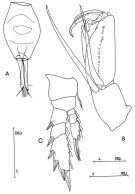 issued from : C. Razouls in Vie Milieu, 1974, 24 (1.A). [p.104, Fig.6]. Female (from W Medit.: Banyuls, France); A, urosome (dorsal); B, A2; C, P1.
|
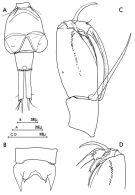 issued from : C. Razouls in Vie Milieu, 1974, 24 (1.A). [p.105, Fig.7]. Male: A, 5th thoracic segment and urosome (dorsal); B, last thoracic segments (dorsal); CD, A2.
|
 issued from : J. Corral Estrada in Tesis Doct., Univ. Madrid, A-129, Sec. Biologicas, 1970. [Lam.59, figs.7-10]. Male (from Canarias Is.): 7, urosome (ventral); 8, idem (lateral right side); 9, A2; 10, exopodal segment 3 of P1.
|
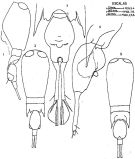 issued from : J. Corral Estrada in Tesis Doct., Univ. Madrid, A-129, Sec. Biologicas, 1970. [Lam.60, figs.1-4].
Female: 3, urosome (dorsal); 4, urosome (lateral right side).
|
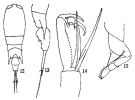 issued from : Q.-c Chen & S.-z. Zhang & C.-s. Zhu in Studia Marina Sinica, 1974, 9. [Pl.15, Figs.12-15]. Female (from China Seas): 12, habitus (dorsal); 13, urosome (lateral right side); 14, A2; 15, P4.
|
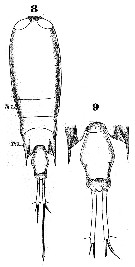 Issued from : W. Giesbrecht in Systematik und Faunistik der Pelagischen Copepoden des Golfes von Neapel und der angrenzenden Meeres-Abschnitte. – Fauna Flora Golf. Neapel, 1892. Atlas von 54 Tafeln. [Taf.51, Figs.10, 11]. As Corycäus flaccus. Female: 10, habitus (dorsal); 11, urosome (dorsal).
|
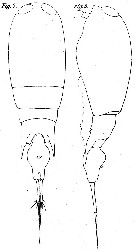 issued from : M. Dahl in Ergebnisse der Plankton-Expedition der Humboldt-Stiftung. Bd II, G. f1. I. Die Corycaeinen 1912. [Taf.V, Figs.4, 5]. Female: 4, habitus (dorsal); 5, idem (lateral left side).
|
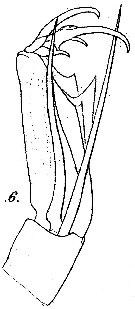 issued from : M. Dahl in Ergebnisse der Plankton-Expedition der Humboldt-Stiftung. Bd II, G. f1. I. Die Corycaeinen 1912. [Taf.V, Fig.6]. Female: 6, A2.
|
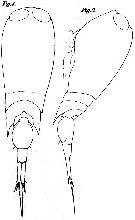 issued from : M. Dahl in Ergebnisse der Plankton-Expedition der Humboldt-Stiftung. Bd II, G. f1. I. Die Corycaeinen 1912. [Taf.V, Figs.8, 9]. Male: 8, habitus (dorsal); 9, idem (lateral left side).
|
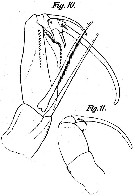 issued from : M. Dahl in Ergebnisse der Plankton-Expedition der Humboldt-Stiftung. Bd II, G. f1. I. Die Corycaeinen 1912. [Taf.V, Figs.10, 11]. Male: 10, A2; 11, Mxp.
|
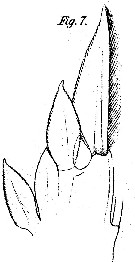 issued from : M. Dahl in Ergebnisse der Plankton-Expedition der Humboldt-Stiftung. Bd II, G. f1. I. Die Corycaeinen 1912. [Taf.V, Fig.7]. Male: 7, terminal portion of exopod of P1.
|
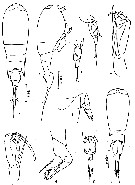 issued from : Z. Zheng, S. Li, S.J. Li & B. Chen in Marine planktonic copepods in Chinese waters. Shanghai Sc. Techn. Press, 1982 [p.138, Fig.86]. Female (from SE Korea): a-b, habitus (dorsal and lateral, respectively); c, A2; d, P4. Male: e, habitus (dorsal); f, urosome (lateral, left side); g, idem (dorsal); h, idem (lateral, right side); i, A2; j, P4. Scale bars in mm.
|
 issued from : F. Cervigon iin Mem. Soc. Cienc. nat. La Salle, 1964, 24 (68). [p.171, Lam.6]. As Agetus flaccus. Female (from Venezuela): 1, habitus (dorsal); 2, abdomen (dorsal); 3, A2; 4, P4. Nota: Lengths ratio abdomen and caudal rami 54:46; 53:47.
|
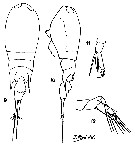 issued from : T. Mori in The Pelagic copepoda from the neighbouring waters of Japan, 1937 (1964). [Pl. 73, Figs.9-12]. Female: 9-10, habitus (dorsal and lateral, respectively); 11, A2; 12, P4.
|
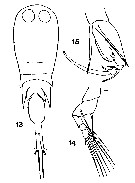 issued from : T. Mori in The Pelagic copepoda from the neighbouring waters of Japan, 1937 (1964). [Pl. 73, Figs.13-15]. Male: 13, habitus (dorsal); 14, P4; 15, A2.
|
 [O & F] Female: Caudal rami more than 1/2 the length of the urosome. Urosome pear-shaped in dorsal view, with a dorsal ''button'' best seen in lateral view. External edge of basipodite 2 of A2 smooth. Male: Eyes separated. Genital segment not as long as the anal segment + caudal rami. [B & H] Female: Caudal ramus more than half length of urosome in dorsal view). Urosome strongly expanded and, in lateral view, with peg like dorsal process. First endopodal segment of A2 lacking teeth on outer margin. Male: Eyes clearly separated. Anal somite 1.3 times longer than wide in doprsal view and combined with caudal rami, longer than genital somite. [V & S] Female: Eyes clearly separated. Caudal ramus length longer than half of the abdomen. Abdomen pear-shaped and streched towards forward; with a ''button'' dorsal (in lateral view). Points of thoracic segment 4 not salient. Basipodite 2 of A2 without spines on the outer margin. Male: Eyes clearly separated. Anal segment 1.3 times longer than wide and, with the caudal ramus longer than the genital segment; posterioe edge not salient in lateral view.
|
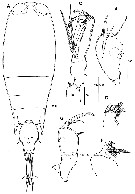 Issued from J.H. Wi, D.H. Kim & H.Y. Soh in Ocean Sci. J., 2013, 48 (4). [p.408, Fig.5]. As Agetus flaccus. Female (from Jeju Island, S Korea): A, habitus (dorsal; arrows indicating fine spinules on mediolateral margin of 2nd urosomal somite); B, 2nd urosomal somite (lateral; arrow indicating small protrusion on mid-region of dorsal surface); C, A2; D, Md; E, Mx1; G, Mxp. Scale bars in µm. Nota: Prosome 2.1 times longer than urosome including caudal ramus, 3.8 times urosome lengths excluding caudal ramus. - Urosome 1.2 times as long as caudal ramus. - 3rd prosomal somite comprising of outer margin formed into long epimeral extension and inner margin with folds in dorsal view, 2.3 times shorter than outer margin - 2nd urosomal somite forming distinct round shape to anterior 2/3 and remaining part gradually tapered, 1.6 times longer than maximum width at mid-region, medial margins laterally fringed with fine hairs (indicated bay arrows). Beneath genital apertures forming small protrusion in mid-region of dorsal surface (indiacted by arrow). -Caudal ramus about 1.2 times shorter than 2nd urosomal somite, 6 times longer than maximum width at base. Caudal setation similar to that of A. typicus, except dorsal seta VII 2,1 times as long as outer lateral seta III. - A1, Md, Mx2, Mxp similar to A. typicus. A2 similar to that of A. typicus except for smaller length ratio of coxobasal seta to 1st endopodal seta (1.1 : 1), as compared to that of A. typicus (1.2 : 1), and relative length of 1st endopodal segment to width at base much smaller (3.3 : 1) than that of A. typicus (4.2 : 1). Mx1 similar to that of A. typicus, but element (A) almost equal to element (B) in length and length ratios of elements about 100.0 : 100.0 : 63.6 : 45.4. - P5 similar to that of A. typicus. - P6 represented by operculum closing off each genital aperture, dorsally located at middle area of 2nd urosomal somite.
|
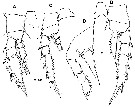 Issued from J.H. Wi, D.H. Kim & H.Y. Soh in Ocean Sci. J., 2013, 48 (4). [p.409, Fig.6]. As Agetus flaccus. Female: A, P1 (posterior view); B, P2 (posterior view); C, P3 (posterior view); P4 (intercoxal sclerite and coxa omitted). Scale bars in µm. Nota: P1-P3 similar to A. typicus. Exopods relative length ratio of terminal spine to distal outer spine of exopodal segment 3 different, relatively, P1 smallest (about 1.8 : 1), in P2 (2.2 : 1), and P3 largest (2.5 : 1), distal segments longer than terminal spines, in P1 (1.7 times longer), and P2-P3 (1.6 times longer). Endopods of P1 to P3 similar to those of A. typicus, except for length ratio of distal segments of P1-P3 about 87.5 : 100.0 : 55.6.
P4 similar to that of A. typicus. But, proportional lengths of each segment 41.9 : 25.8 : 32.3, in exopods outer terminal spine 1.4 times shorter than distal segment, and termunal spine 1.9 times longer than proximal spine, basal seta almost slightly longer (1.1 times) than endopodal seta.
|
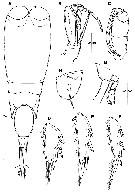 Issued from J.H. Wi, D.H. Kim & H.Y. Soh in Ocean Sci. J., 2013, 48 (4). [p.410, Fig.7]. As Agetus flaccus. Male: A, habitus (dorsal); B, A2; C, Mxp; D, P1 (exopodite 2); E, P2 (exopodite 3); F, P3 (exopodite 3); G, P4 (intercoxal sclerite and coxa omitted); H, genital flap and P6. Scale bars in µm. Nota : Prosome 3-segmented, about 1.6 times longer than urosome including caudal rami, 2.4 times of urosome length excluding caudal rami. - 3rd prosomal somite with outer and inner epimeral extensions: outer one extended and pointed, reached to 40% of genital somite. - 2 large contiguous cuticular lenses very close to each other on frontal part. - Genital somite oval, 1.7 times as long as maximum width at mid-region.. Genital area formed into flaps derived from P6. - Anal somite slightly narrowed about 1.2 times as long as wide at base, with large opening dorsally, 2.7 times shorter as long as genital somite. - Caudal ramus 6.7 times longer than wide at base, about 1.4 tiçmes shorter than genital somite. Armature of rami similar to that of female, but seta III 1.5 times shorter than seta VII. - A1, A2, Md, Mx1, Mx2 similar to that of A. typicus. - Mxp similar to that of A. typicus, except for relatively longer inner accessory seta (about twice times) compared to outer accessory seta on terminal claw. -P1-P3 in segmentation and armature similar to those of female. Exopodal segments 3 length ratios of terminal spine to distal outer spine different to those of female, P1, P2, and P3 1.9 : 1, 2.1 : 1, 3.2 : 1, respectively, length ratios of distal segment to terminal spine, in P1 almost equal, in P2 slightly larger (1.8 : 1), and P3 smaller (1.3 : 1). P4 similar to that of A. typicus, except basal seta 1.3 times longer than endopodal seta and distal segment 2.4 times longer than terminal spine. - P6 represented by genital flap closing off each genital aperture , armed with long seta and small process near its base, and 2 small secretory pores closely located, compared to those of A. typicus.
|
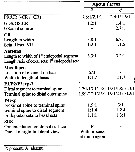 Issued from J.H. Wi, D.H. Kim & H.Y. Soh in Ocean Sci. J., 2013, 48 (4). [p.406, Table 2]. As Agetus typicus. Female & Male: morphological characters. PR: prosome; UR: urosome; -CR: including CR; +CR: excluding CR: SUS/GS: 2nd urosomal somite/genital somite. Nota: Compare with Agetustypicus and Agetus limbatus.
| | | | | Compl. Ref.: | | | Rose, 1925 (p.153); Massuti Alzamora, 1942 (p.106, Rem.); Sewell, 1948 (p.393, 434, 461, 515); C.B. Wilson, 1950 (p.193); Yamazi, 1958 (p.155, Rem.); V.N. Greze, 1963 a (tabl.2); Shmeleva, 1963 (p.141); Duran, 1963 (p.26); Björnberg, 1963 (p.85, Rem.); De Decker & Mombeck, 1964 (p.12); Pavlova, 1964 (p.1711); Shmeleva, 1965 b (p.1350, lengths-volume-weight relation); Pavlova, 1966 (p.45); Furuhashi, 1966 a (p.295, vertical distribution in Kuroshio region, Table 10); Neto & Paiva, 1966 (p.32, Table III); Mazza, 1966 (p.74); 1967 (p.367); Ehrhardt, 1967 (p.743, geographic distribution, Rem.); Séguin, 1968 (p.488); Evans, 1968 (p.12); Dowidar & El-Maghraby, 1970 (p.268); Deevey, 1971 (p.224); Apostolopoulou, 1972 (p.329, 384, fig.12); Binet & al., 1972 (p.69); Marques, 1974 (p.12); Björnberg, 1973 (p.367, 385); Vives & al., 1975 (tab.II); Lakkis & Abboud, 1976 (p.81); Boxshall, 1977 b (p.555); Deevey & Brooks, 1977 (p.156, tab.2, Station "S"); Dessier, 1979 (p.208); Vaissière & Séguin, 1980 (p.23, tab.2); Vives, 1982 (p.296); Kovalev & Shmeleva, 1982 (p.86); Scotto di Carlo & al., 1984 (p.1041); Guangshan & Honglin, 1984 (p.118, tab.); Regner, 1985 (p.11, Rem.: p.42); Moraitou-Apostolopoulou, 1985 (p.303, occurrence/abundance in E Mediterranean Sea, Rem.: p.310); Jansa, 1985 (p.108, Tabl.I, II, III, IV, V); Brinton & al., 1986 (p.228, Table 1); Jimenez-Perez & Lara-Lara, 1988; Lozano Soldevilla & al., 1988 (p.61); Cervantes-Duarte & Hernandez-Trujillo, 1989 (tab.3); Hirakawa & al., 1990 (tab.3); Yoo, 1991 (tab.1); Hernandez-Trujillo, 1991 (1993) (tab.I); Webber & Roff, 1995 (tab.1); Shih & Young, 1995 (p.76); Kotani & al., 1996 (tab.2); Webber & al., 1996 (tab.1); Suarez-Morales & Gasca, 1997 (p.1525); Park & Choi, 1997 (Appendix); Hure & Krsinic, 1998 (p.92, 105); Alvarez-Cadena & al., 1998 (t.2,3,4); Suarez-Morales & Gasca, 1998 a (p.112); Noda & al., 1998 (p.55, Table 3, occurrence); Lapernat, 1999 (p.31); Siokou-Frangou, 1999 (p.479); Hernandez-Trujillo, 1999 (p.284, tab.1); Lavaniegos & Gonzalez-Navarro, 1999 (p.239, Appx.1); Razouls & al., 2000 (p.343, tab. 5, Appendix); El-Sherif & Aboul Ezz, 2000 (p.61, Table 3: occurrence); Fernandez-Alamo & al., 2000 (p.1139, Appendix); Suarez-Morales & Gasca, 2000 (1247, tab.1); Suarez-Morales & al., 2000 (p.751, tab.1); Lopez-Salgado & al., 2000 (tab.1); Alvarez-Silva & Gomez-Aguirre, 2000 (p.163: tab.2); Lapernat & Razouls, 2001 (tab.1); Vukanic, 2003 (p.139, tab.1); Hsieh & al., 2004 (p.398, tab.1); Chang & Fang, 2004 (p.456, tab.1); Lan & al., 2004 (p.332, tab.1); Lo & al., 2004 (p.89, tab.1); Kazmi, 2004 (p.231); Isari & al., 2006 (p.241, tab.II); Lavaniegos & Jiménez-Pérez, 2006 (p.141, tab.2, Rem.); Khelifi-Touhami & al., 2007 (p.327, Table 1); Hwang & al., 2007 (p.25); Jitlang & al., 2008 (p.65, Table 1); Lan Y.-C. & al., 2008 (p.61, Table 1, % vs stations); Ayon & al., 2008 (p.238, Table 4: Peruvian samples); Morales-Ramirez & Suarez-Morales, 2008 (p.524); C.-Y. Lee & al., 2009 (p.151, Tab.2); Brugnano & al., 2010 (p.312, Table 3); Williamson & McGowan, 2010 (p.273, Table 3, Pacific central gyres: N and S); Hidalgo & al., 2010 (p.2089, fig.4, Table 2, cluster analysis); Mazzocchi & Di Capua, 2010 (p.428); Medellin-Mora & Navas S., 2010 (p.265, Tab. 2); W.-B. Chang & al., 2010 (p.735, Table 2, abundance); Hafferssas & al., 2010 (p.1281, Table III, abundance vs spatial distribution); Hsiao S.H. & al., 2011 (p.475, Appendix I); Maiphae & Sa-ardrit, 2011 (p.641, Table 2, 3, Rem.); Andersen N.G. & al., 2011 (p.71, Fig.3: abundance); Selifonova, 2011 a (p.77, Table 1, alien species in Black Sea); Tutasi & al., 2011 (p.791, Table 2, abundance distribution vs La Niña event); Shiganova & al., 2012 (p.61, Table 4); Uysal & Shmeleva, 2012 (p.909, Table I); Salah S. & al., 2012 (p.155, Tableau 1); in CalCOFI regional list (MDO, Nov. 2013; M. Ohman, comm. pers.); Tseng & al., 2013 (p.507, seasonal abundance); Lidvanov & al., 2013 (p.290, Table 2, % composition); Bonecker & a., 2014 (p.445, Table II: frequency, horizontal & vertical distributions); Zaafa & al., 2014 (p.67, Table I, occurrence): Mazzocchi & al., 2014 (p.64, Table 3, 4, occurrence); Fierro Gonzalvez, 2014 (p.1, Tab. 3, 4, 5, occurrence, abundance); Dias & al., 2015 (p.483, Table 2, abundance, biomass, production); Rojas-Herrera & al., 2016 (p.40, Table 2: temporal abundance); Benedetti & al., 2016 (p.159, Table I, fig.1, functional characters); Benedetti & al., 2018 (p.1, Fig.2: ecological functional group); Palomares-Garcia & al., 2018 (p.178, Table 1: occurrence) | | | | NZ: | 18 | | |
|
Distribution map of Corycaeus (Agetus) flaccus by geographical zones
|
| | | | | | | | | | | | | | |  issued from : A.A. Shmeleva in Bull. Inst. Oceanogr., Monaco, 1965, 65 (n°1351). [Table 6: 45]. As Corycaeus flacus (from South Adriatic). issued from : A.A. Shmeleva in Bull. Inst. Oceanogr., Monaco, 1965, 65 (n°1351). [Table 6: 45]. As Corycaeus flacus (from South Adriatic).
Dimensions, volume and Weight wet. Means for 50-60 specimens. Volume and weight calculated by geometrical method. Assumed that the specific gravity of the Copepod body is equal to 1, then the volume will correspond to the weight. |
| | | | Loc: | | | Antarct. (Ross Sea, in Farran, 1929), South Africa (E), Angola, Baia Farta, Congo, off Trindade Is., G. of Guinea, Ivorian shelf, off Morocco-Mauritania, Cap Ghir (Morocco), Moroccan coast, Canary Is., off Madeira, Rio de Janeiro, Campos Basin, Barbada Is., Caribbean Sea, Jamaica, Caribbean Colombia, Yucatan, G. of Mexico, Cuba, Florida, Sargasso Sea, off Bermuda (Station "S"), off W Azores, Portugal, Ibero-moroccan Bay, off W Tangier, Medit. (Alboran Sea, Habibas Is., Sidi Fredj coast, Algiers, Gulf of Annaba, Castellon, Baleares, Banyuls, Marseille, Ligurian Sea, Tyrrhenian Sea, Strait of Messina, Gulf of Taranto, NW Tunisia, Malta, Adriatic Sea, Ionian Sea, Aegean Sea, Black Sea, Lebanon Basin, W Egyptian coast, Alexandria), Sharm El-Sheikh, Taba, Red Sea, Madagascar (Nosy Bé), Pakistan, Indian, Bay of Bengal, G. of Thailand, Philippines, China Seas (Yellow Sea, East China Sea, South China Sea), Taiwan Strait, Taiwan (E, S, W, Kaohsiung Harbor, NW, N: Mienhua Canyon, NE), S Korea (Jeju Is.), S Japan Sea, Japan, Kuchinoerabu Is., Tanabe Bay, Bering Sea, Aleutian Is. (in C.B. Wilson, 1950, p.193), Pacif. (W equatorial), Pacific (central gyres: N and S), Australia (Great Barrier, North West Cape), New Caledonia, New Zealand, Fidji Is., off Hawaii, California (San Pedro Bay), W Baja California, La Paz (Mexico), Gulf of California, W Mexico, Acapulco Bay (rare), G. of Tehuantepec, W Costa Rica, Galapagos-Ecuador, Peru, Chile (N) | | | | N: | 202 | | | | Lg.: | | | (34) F: 1,75-1,66; (35) [Atlant. trop.] F: 1,7-1,66; M: 1,38-1,15; [N-Z] F: 1,85-1,8; M: 1,68-1,55; (46) F: 1,8-1,65; (91) F: ± 1,8; M: ± 1,6; (107) F: 1,67-1,56; M: 1,39-1,37; (109) F: 1,7; (180) F: 1,73-1,69; M: 1,52-1,42; (327) F: 1,89-1,75; M: 1,59-1,51; (340) F: 1,2; M: 1,4; 1,3; (618) F: 1,77-1,62; (667) F: 1,75-1,6; M: 1,57-1,4; (668) F: 1,6-1,5; (670) F: 1,78-1,63; M: 1,5-1,44; (920) F: 1,63; (991) F: 1,56-1,67; M: 1,37-1,39; (1023) F: 1,63-1,67; M: 1,5-1,56; (1150)* F: 1,64-1,69; M: 1,54-1,55; {F: 1,20-1,89; M: 1,15-1,68}
* Total body length in lateral view. | | | | Rem.: | epi-mesopelagic.
Sampling depth (Antarct.) : 0-1000 m. Overall Depth Range in Sargasso Sea: 0-500 m (Deevey & Brooks, 1977, Station "S"). For Acha & al. (2020) this species is observed offshore on southern shelf and also northern shelfbreak in front of Rio de La Plata (Argentina).
For Boxshall & Halsey (2004, p.491) the subgenus (Dahl, 1912) is considered as full generic status pending phylogenetic revision of the whole family at the generic level.
Originally from the Aegean Sea into the Black Sea.
After Wi & al. (2013, p.411) this species from Korean waters agree well with Giesbrecht (1892) original description, which are characterized by a rounded process on the dorsal surface of the 2nd urosomal somite in lateral view. Morphological characters of A. flaccus are differentiated from other species of Agetus as following (see Table 2): in female 1- the 2nd urosomal somite laterally fringed with fine setules along the medial margin; 2- the length ratio of outermargin to inner margin of 4th pedigerous somite is much larger: 3- the ratio of length to width at the base of caudal ramus is smaller than in A. typicus and larger than A. linbatus; in male, 4- in A2, coxobasal seta is slightly shorter than the 1st endopodal seta; 5- the genital somite is shorter than the combined length of anal and caudal rami. In addition, location of secretory pores on surface of genital flap in male and relative lengths of spine on exopodal segment 3 in P1-P3 in both sexes differed from those of other species of Agetus.The occurrence of this species in the East China Sea and the Yellow Sea is related to the intrusion of the Kuroshio branch current into northern Taiwan Strait in the spring season. As long as the warming trend of sea surface temperature appears continue, more warm-water species, as Agetus limbatus and Agetus typicus (also less cold-water species) are expected to be found in Korean waters. These species of Agetus can be used as a basis tool to understand the flow direction of warm currents and the long term variation in marine biodiversity related to climate change.
After Benedetti & al. (2018, p.1, Fig.2) this species belonging to the functional group 2 corresponding to small ambush feeding carnivorous.
See in DVP Conway & al., 2003 (version 1) | | | Last update : 25/10/2022 | |
|
|
 Any use of this site for a publication will be mentioned with the following reference : Any use of this site for a publication will be mentioned with the following reference :
Razouls C., Desreumaux N., Kouwenberg J. and de Bovée F., 2005-2025. - Biodiversity of Marine Planktonic Copepods (morphology, geographical distribution and biological data). Sorbonne University, CNRS. Available at http://copepodes.obs-banyuls.fr/en [Accessed October 21, 2025] © copyright 2005-2025 Sorbonne University, CNRS
|
|
 |
 |
























